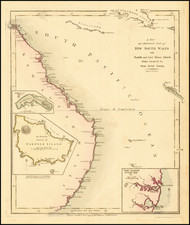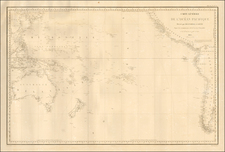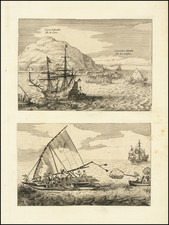Scarce map of the bay and coast of the South Seas island of Futuna (Hoorn), from the voyage of Le Maire and Schouten.
The bay shown was named after the ship Eendrachts (Unity Bay).
Willem Cornelisz Schouten (1567-1625) was a navigator for the Dutch East India Company. He was the first to sail the Cape Horn route to the Pacific Ocean. Jacob le Maire (1585-1616) was a Dutch mariner who circumnavigated the earth in 1615-1616.
In 1615, Willem Cornelisz Schouten and Jacob le Maire sailed from Texel, in the Netherlands, in command of an expedition sponsored by Isaac Le Maire and his Australische Compagnie in equal shares with Schouten. One of the reasons for the voyage was to search for Terra Australis, which eluded them. A further objective was to evade the trade restrictions of the Dutch East India Company (VOC), by finding a new route to the Pacific and the Spice Islands.
In January 1616, they rounded Cape Horn, which Schouten named for his birthplace, the Dutch city of Hoorn and proceeded west. After failing to moor at the Juan Fernández Islands in early March, the ships crossed the Pacific in a fairly straight line, visiting several of the Tuamotus. Between April 21 and April 24, 1616, they were the first Westerners to visit the Northern Tonga islands: "Cocos Island" (Tafahi), "Traitors Island" (Niuatoputapu), and "Island of Good Hope" (Niuafo'ou). On April 28, they discovered the Hoorn Islands (Futuna and Alofi), where they were very well received and stayed until May 12. They then followed the north coasts of New Ireland and New Guinea and visited adjacent islands, including, on July 24, 1616, what became known as the Schouten Islands.
They reached the Northern Moluccas in August and finally Ternate, the headquarters of the VOC, on September 12,1616. Here they were enthusiastically welcomed by Governor-General Laurens Reael, admiral Steven Verhagen, and the governor of Ambon, Jasper Jansz.
They sailed on to Java and reached Batavia on October 28, 1616. Although they had opened an unknown route, Jan Pietersz Coen of the VOC claimed infringement of its monopoly of trade to the Spice Islands. Le Maire and Schouten were arrested and the Eendracht was confiscated. After being released, they returned from Batavia to Amsterdam in the company of Joris van Spilbergen, who was on a circumnavigation of the earth himself, be it via the traditional Strait of Magellan.
Le Maire was aboard the ship Amsterdam on this journey home, but died en route. Van Spilbergen was at his deathbed and took Le Maire's report of his trip, which he included in his book Mirror of the East and West Indies. The rest of the crew arrived in the Netherlands on July 1, 1617. Jacob's father Isaac, challenged the confiscation and the conclusion of the VOC, but it took him until 1622 until a court ruled in his favor. He was awarded 64,000 pounds and retrieved his son's diaries (which he then published as well), and his company was allowed trade via the newly discovered route. Unfortunately, by then, the Dutch West Indies Company had claimed the same waters.









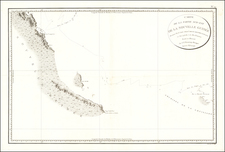
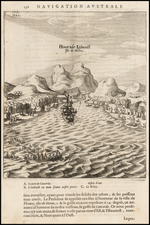
![(Pape'ete, French Polynesia) Rade & Port de Pape-Iti Arrivée au mouillage du C. Amiral Dupetit Thouars. [Harbor and port of Papeete. Arrival at anchorage by Rear Admiral Dupetit Thouars]](https://storage.googleapis.com/raremaps/img/small/78559.jpg)
